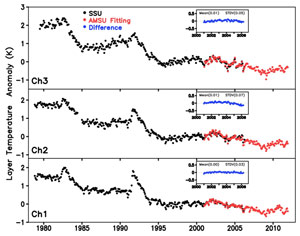- STAR Home
- > SMCD Home
- > Suomi NPP CrIS Full Spectral Resolution SDR Products using STAR Offline Processing System
Developing Algorithms to Merge SSU and AMSU Observations for Generation of Stratospheric Temperature Climate Data Record From 1979 to Present
Principal Investigator: Cheng-Zhi Zou

Click to enlarge - Global mean anomaly time series for the three SSU
channels and their AMSU-A equivalents after applying the merging
algorithms. The blue lines in the inserted boxes are the difference time
series between SSU channels and their AMSU-A equivalents derived from the
merging algorithms during their overlapping observations.
The stratospheric temperature trends are one of the central
indicators for anthropogenic global warming. Observations from the
Stratospheric Sounding Unit (SSU) onboard NOAA historical polar orbiting
satellites have been playing a vital role in detecting the long-term
trends and variability in the middle and upper stratospheric
temperatures during 1979-2006. The SSU successor is the Advanced
Microwave Sounding Unit-A (AMSU-A) starting from 1998 until present. It
is desirable to merge the two observations together to extend the SSU
data record to provide continued monitoring of changes in the
stratospheric temperatures from 1979 to present. Unfortunately, the two
observations came from different atmospheric layers with the SSU
weighting functions covering atmospheric layers much thicker than those
of the AMSU-A channels. In addition, the SSU weighting function varies
with time and locations, posing a challenge to merge with AMSU-A with
accuracy high enough for development of climate-quality data record.
In FY2015, STAR scientists developed a novel variational approach for
the SSU and AMSU-A merging, accounting for matching in both of their
temperatures and weighting functions. The approach solves for time- and
latitudinal-dependent merging coefficients from a variational equation
specifically designed for this problem, and it yielded zero mean inter-
satellite biases with small standard deviation and negligible bias drift
over time between SSU and its derived AMSU-A equivalent during their
overlapping period (see Figure below). The solution satisfies the
necessary condition for the merged time series to reliably detect long-
term climate trend. Meanwhile, their weighting functions were matched
with reasonably good accuracy, ensuring the merging is physically sound.
The global mean temperature trends during 1979-2015 derived from the
merged time series were -0.64, -0.69, -0.77 K/Dec, respectively, for the
three extended SSU channels, representing layer mean temperatures of the
mid-stratosphere, upper-stratosphere, and top-stratosphere. This cooling
effect is consistent with predictions from the anthropogenic global
warming theories that both increases of carbon dioxide (and other
greenhouse gases) and ozone depletion will cause a cooling response in
the stratospheric temperatures. The merged observations were also
compared with climate model simulations from the Coupled Model
Intercomparison Project Phase 5 (CMIP-5). Excellent agreement was found
for global as well as latitudinal mean trends.
In conclusion, the extended SSU time series was demonstrated to be a
credible dataset in monitoring changes in the stratospheric temperatures
and verifying climate model simulations of the anthropogenic global
warming effect.
|

